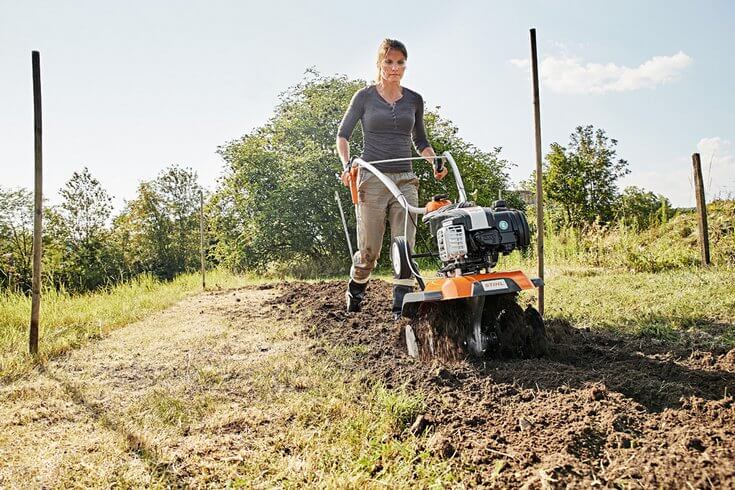
As we move to the end of the growing season, our attention turns to rejuvenating the soil so that it is in the best possible condition at the start of next year’s growing season.
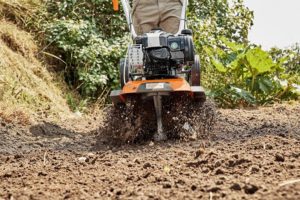
Enriching the soil in the autumn, be it with compost, mulch or manure, allows nature to do its work over the autumn, winter and early spring so the soil is in an optimal condition ready for plants to grow when the weather warms up. Using a garden tiller means that you can break the soil up into smaller pieces and combine the compost or manure into it. Breaking it up also improves the aeration of the soil.
Here at STIHL GB, we have three tillers available with a range of accessories to help make this job and other soil preparation tasks a whole lot easier. But first, what is a tiller and how do they work?
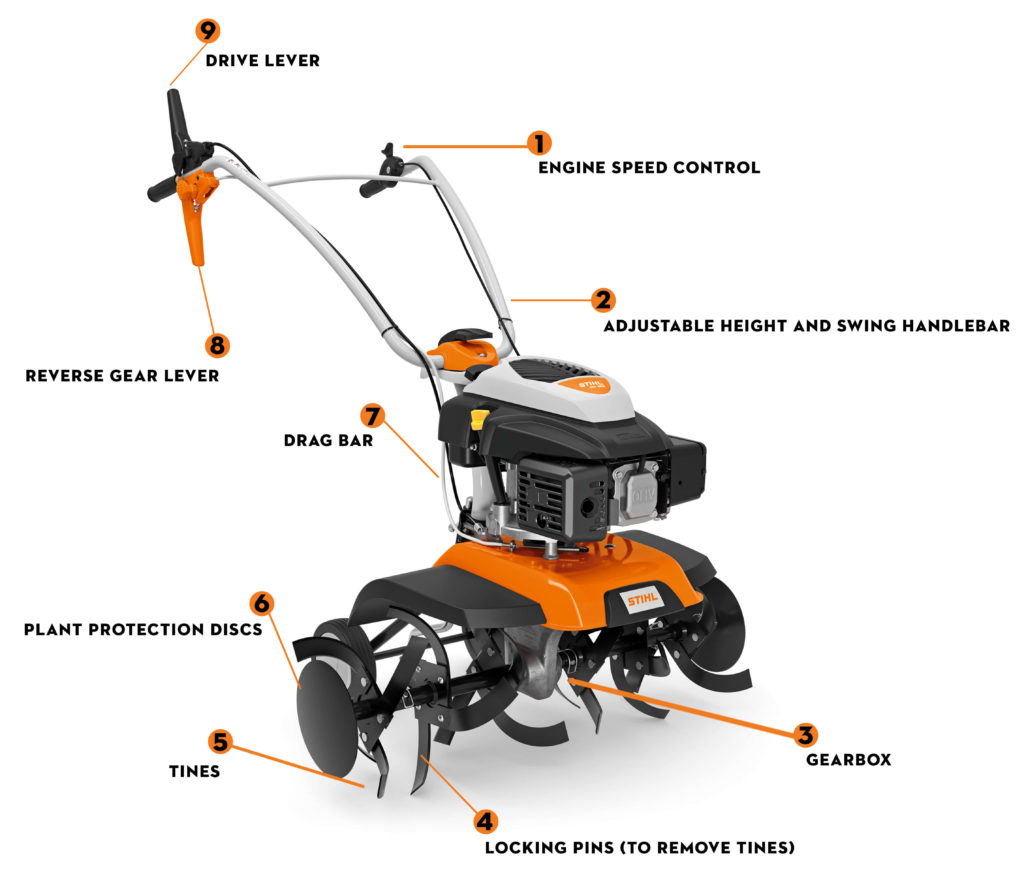
- This is the engine speed control; it adjusts the speed that the tines rotate when drive is engaged.
- Adjustable height and swing handlebar; this makes sure that the machine is working flat and level when the user is in a comfortable standing position. The swing function is used to bring the controls around to the left or right side so that the operator does not have to walk on the freshly tilled soil.
- The gearbox; this transfers the engine drive to the tiller attachment (either the tines or wheels).
- Locking pins; these are situated on the tine shafts and gearbox driveshafts so that the tines can be removed for different attachments or added/removed to change the tilling width.
- Tines; they are grouped together rotating as a four. The leading edge needs to maintain a spade-like sharpness, particularly when working in compacted soil.
- Plant protection discs; these are removable (like the outermost tines) so that greater tilling performance can be achieved. They are used to prevent shoots and roots of adjacent plants from being picked up by the tines and being damaged.
- Drag bar; this is perhaps the most important feature of a tiller. The drag bar is adjusted according to the tilling depth. As the name suggests it drags along the ground like an anchor so the tiller doesn‘t race off along the surface of the soil. You can push down on the drag bar to slow the tiller allowing it to dig in more to till the soil.
- Reverse gear lever; this is used to help manoeuvre the tiller, especially in tricky positions like against a fence or wall or even just turning the machine 180 degrees to make another run over the soil. The reverse gear is much slower than the forward gear (slow walk) and is only used for moving the tiller around, not tilling.
- Drive lever; this engages the tiller drive shafts to spin the attachment (tines or wheels).
- Transport wheels; can be flipped up when the machine is working or moved down when needing to transport the tiller away from the working area.

- Non-adjustable ridger; this is an optional accessory and can be attached where the drag bar is usually fitted. This version creates a furrow and ridge a fixed width apart. It would usually be used in combination with drive wheels for the best result but can be used with tines on their own as well.

- Adjustable ridger; this is another accessory. With this version, the boards of the ridger can be widened so that you can set the width of the furrow and ridge, which can be useful for specific plants.

- Steel wheels; these are also optional and are fitted when using the tiller to pull attachments, such as the ridgers.

- Weights; can be useful to prevent the machine from bouncing or skidding on compacted/tougher soil. The user doesn‘t have to hold on or push down on the drag-bar so much.

What Tiller Do You Need?
The MH 445 is a great compact tiller for getting essential soil prep done at the end of the season. Featuring four rows of tines with a diameter of 30cm and a working width of 45cm, the STIHL MH 445 with its 140cc engine is perfect for tilling open vegetable patches. The two of the outmost tines can be removed to reduce the tilling width to 28cm allowing the MH 445 to work between rows of vegetables. With the addition of protection discs on the outer tines, you can also protect adjacent plants and their roots from being damaged when the tines pass by.
The AHV 600 is an additional tine set that can be added to increase the tilling width to 62 cm so that even greater areas can be tilled quicker.
The MH 445 R adds a reverse gear to the standard MH 445, which is useful if you need to till in tighter areas or manoeuvre around other plants and vegetable patches.
The STIHL MH 585 is our largest tiller sold in Great Britain, with a 150cc Kohler engine, 85cm tilling width and six rows of 32cm diameter tines. This model is built for heavier work than the MH 445 models and with greater flexibility too. It also has a reverse gear for easier movement.
When tilling, weight is a benefit as the tines on a heavier machine will dig into the soil more and make the work easier. At 44kg the MH 585 is certainly heavy but this can be added to with the help of the AZG 030 weights, adding an additional 18kg to the machine. With the total weight at 62kg, the tines will work even more effectively particularly in tough compacted soil.
The outmost row of tines can also be removed so the MH 585 can work in tighter areas between rows of plants as well as being more effective in compacted soil with a reduced surface area. At its narrowest with four rows of tines, it has a 59cm tilling width. The MH 585 is also great for ridging. You can fit the AMR 031 iron wheels to accompany either the adjustable AHK 701 or fixed AHK 702 ridgers, to fully prepare the ground for planting vegetables.
Are you doing soil preparation on your allotment right now? Would a garden tiller make your life easier? Let us know in the comments!



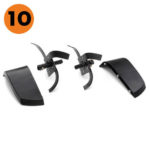
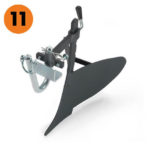
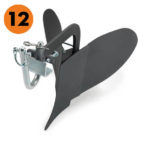
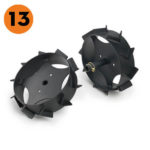


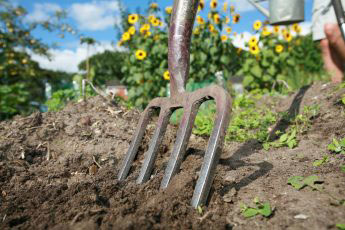
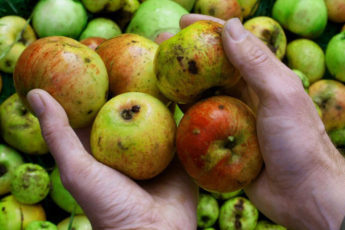
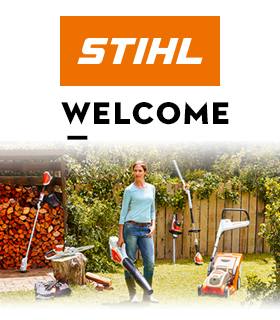








Leave a Comment